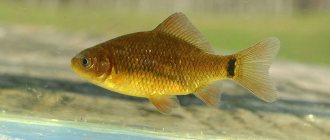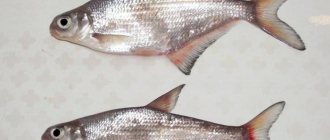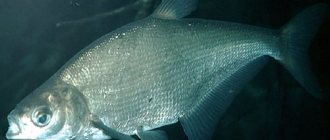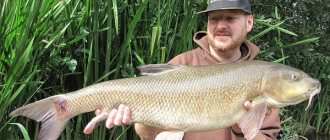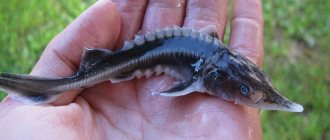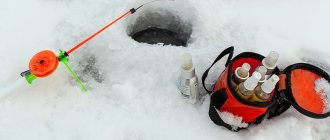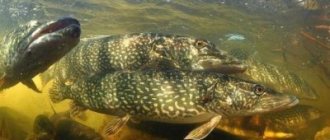Types and subspecies of trout
Types are divided into:
- Salmo - these include subspecies: Adriatic, Sevan, Amu Darya, Turkish flathead, brown trout (also has several subspecies), marbled, summer trout;
- Oncorhynchus - these include Arizona, golden, biwa trout, Clark's salmon, Mikizha;
- Salvelinus – this species includes American palia, big-headed loach, Dolly Varden, Lake cristome loach, silver loach.
Where is trout found in Russia?
This type of salmon can be found today in many reservoirs of Russia:
- numerous lakes of Karelia;
- freshwater reservoirs of the Kola Peninsula;
- Lakes Onega and Ladoga;
- artificial ponds within the boundaries of many large cities, specially stocked with rainbow trout mainly for sport fishing.
The fish is also widespread in the territory of the former USSR republics in Asia. For example, in the large alpine Lake Sevan, which is located in Armenia, there is a unique local species - Sevan trout, often used in national dishes.
Lifestyle
This fish chooses exceptionally clean habitats: fresh, cold springs with a transparent rocky bottom. Once a reservoir becomes polluted, trout are the first to die of all the underwater fauna. It follows that trout meat is environmentally friendly, and therefore healthy.
After spawning, the fish move down to the river beds and stay closer to the bottom. It feeds on minnows (small fish).
In summer, when the water warms up by more than 15°, schools stay at the mouths of rivers and springs, since the water temperature there is much lower.
Article on the topic: Fluorocarbon fishing line
Individuals that have not reached half a kilo in weight are not predators and parasitize at the expense of their older relatives, feeding on their eggs. In addition, they feed on earthworms, which are washed out of the soil with rain.
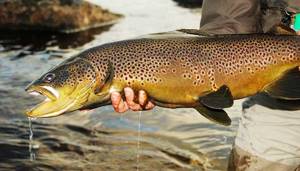
Description
Many fishermen are interested in where trout are found in the Moscow region, Leningrad region and other regions of our country. We should start with a detailed description of this aquatic inhabitant.
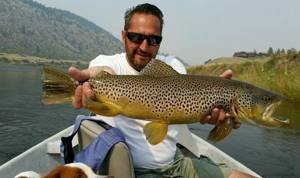
Trout belongs to the salmon family. This is one of the most coveted trophies of fishermen in Russia and other countries. This is a fairly strong fish, which causes a lot of problems when fishing.
Trout has a flattened body laterally. The muzzle is short. Adult fish reaches 25-35 cm in length. Its weight is 250-600 g. The largest individuals are found in Karelian reservoirs. There is plenty of food here for trout. Therefore, here you can find fish of this family, whose weight reaches 2 kg. The record trout weight was 5 kg.
This predatory fish has two rows of teeth. The dorsal fins have dots, and the ventral fins are light with yellowish tint.
Diet
This is a very voracious fish. Eats all year. The amount of food eaten per day corresponds to 2/3 of its weight. When catching fish, it is important to know what trout eat: plankton, fry, insects, and crustaceans are part of its diet. As fish age, their appetites increase: they hunt small fish or eat younger relatives. Predators jump like flying fish above the water, which allows them to feast on winged insects. A lot of food gets into the water thanks to the wind. Grasshoppers, flies, and midges also form part of the fish’s diet.
Trout breeding
Trout, during spawning, behaves very interestingly, like all representatives of the salmon family. Rarely, but during this period, fish can be seen near the shore or on the surface of the reservoir. It rises briefly and behaves very actively: it moves quickly through the water and splashes heavily.
Trout conduct mating games on the surface of the reservoir. After their completion, the young animals return to their usual life and sink to the bottom or return to their native reservoir. The other part will remain here until the period of spawning.
Trout are not prolific. A female can be considered mature only in the third year of life. The larvae appear only in early spring. At first, they are completely motionless and feed on the food that is in the bag. Only after 40 days do they begin to move a little, and then leave their shelter.
The trout immediately shows their predatory nature and immediately begins to feed on small insect larvae. In the first 2-3 months, the larvae grow very quickly, then their growth slows down a little. In a year, the fish grows up to 15 centimeters. The growth rate is affected by the water in the reservoir and its size. For example, in a large lake they have more food than in a small body of water. You won’t find huge trout in small rivers; they grow no more than 20 centimeters in length.
What to do with trout caviar
The eggs of any type of trout are small, about 3 mm, and have a characteristic dark orange hue. Experienced housewives know how to properly salt caviar. It is better to salt caviar with added sugar. Home-salted caviar tastes better, but has a shorter shelf life, so it is better to store it in the freezer. This will not change the taste and quality of the product.

Breeding trout in fish farms
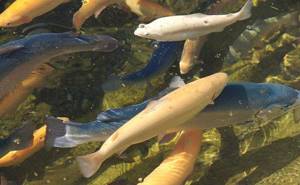
This tasty and expensive variety of salmon is of interest to fish farms and nurseries. Of all the species, only a small part is suitable for cultivation.
We recommend reading: Fishing for carp: how to properly catch carp in a pond and on a river
Keeping in cages

Keeping them in special cages is considered the most profitable way of growing. The cages are placed in a certain part of a suitable body of water. It's quite simple to do:
- In pre-marked places, wooden or metal stakes are driven into the bottom of the reservoir, which define the boundaries of the cage and will later serve as a frame.
- A strong fine-mesh mesh is stretched over the stakes. The size of the cell is selected so that trout fry cannot leave the cage area, but at the same time the fry of other fish and small aquatic life can easily penetrate.
- The diameter of such a structure is usually 15-20 meters, and the depth is about 5 meters. The bottom of the cage is located approximately one meter above the bottom of the reservoir.
Contents in the pond
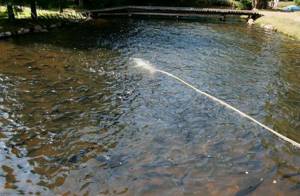
Reservoirs, both natural and artificial, are suitable for growing trout in a pond. Moreover, natural ponds, in some cases, are inferior to artificial reservoirs specially dug for growing fish. This is explained simply:
- In a wild pond it is more difficult to create the necessary conditions for the life of fish that require clean water.
- A large natural reservoir cannot be completely cleared of trash fish and excess vegetation.
- On private property it is much easier to protect a pond from poachers.
The advantage of a natural reservoir is only the supply of natural food, which allows partial savings on feed. In a body of water of any type there must be at least a slight current that promotes constant mixing of oxygen in the water.
Fishing Features
Where trout live there are cold and clean water reservoirs. Therefore, the spring season is suitable for fishing, before the water becomes cloudy from high water. Do not forget that during the spawning period, which mainly occurs in autumn, fishing is prohibited. In summer, due to the heat, the fish are not so active, so fishing will be successful only at night, in the morning or in the evening.

Since insects are part of the trout's diet, you can fish with a fly. Dung and earthworms, larvae of any insects, and maggots are optimal as bait. Corn, cheese, and small fish are also suitable for bait. Predators react to anything bright - use colorful, catchy baits.
In the summer, when the water warms up greatly, schools of trout flock to the mouths of rivers and springs, because they feel comfortable there. Therefore, knowing the places, large individuals can be caught with bare hands.
Where does it live?
Trout chooses habitats in many water basins of our country:
- water space of Siberia;
- water spaces of Karelia and the Caucasus, the Kola Peninsula;
- basins of the Caspian, Okhotsk and Black Seas;
- Lakes Ladoga and Onega.

Fish farming organizations create artificial rates for its industrial breeding. The trout that inhabits the waters of our country are similar in color and body structure. It has an elongated shape with compression on the sides. The body is covered with small scales with small dark spots. It has a medium-sized, truncated head with small eyes and a mouth.
Piques interest! The color of the skin depends on the soil of the habitat, transparency and illumination of the water bottom.
Rainbow
It is a relative of the Pacific salmon, but unlike it, it lives in fresh water basins. This is the most common class of trout in the country.
The elongated body of an adult fish reaches 50 centimeters, and the weight ranges from 1.2 to 1.5 kg. Females are larger in size compared to males.
It got its name due to its variegated color. Usually its belly is lighter with a silvery tint, and its back often acquires a greenish tint, on which there are many small dark spots. During the spawning period, the stripe that runs along the body is painted with bright scarlet and purple colors. This feature of the skin influenced its name.
Preferably lives in clean mountain streams. In Russia it is found everywhere. The largest population of trout habitat is located in Kamchatka and the Sea of Okhotsk. It is often used for breeding, populating paid ponds.
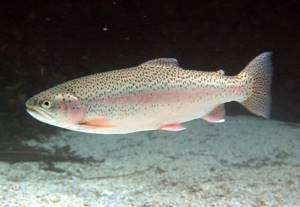
Regular
The microclimate of Russian water spaces is suitable for representatives of the Atlantic group family:
- lake or Karelian: lives in the Ladoga and Onega basins, where the depth sometimes reaches 100 m. The largest adult individuals reached sizes up to 1 m;
- Brook trout: otherwise called brown trout. This representative of the breed leads a sedentary lifestyle, preferring clear, cold water with strong currents or spring sources. This breed chooses freshwater pools for its habitat. These can also be streams or forest channels. An adult brook fish weighs from 1 to 2 kg.

Crimean
Crimean trout is found in the Black Sea. It goes to spawn in many upper reaches of Crimean rivers, streams of the Southern Bank, and local reservoirs. After spawning, it returns to the sea, and some individuals choose freshwater reservoirs for permanent residence.
It is distinguished by characteristic dark and red spots with a white border, scattered throughout the body, and a fatty process located between the dorsal and caudal fin.
These groups do not exist in isolation, but flow into each other.

Tackle
Depending on the fishing gear, we choose bait.
- Fishing rod . If the fishing rod is a float, for fishing in the river it is better to use small crustaceans or their meat, or beetles of different shades. But it’s better to ask what the fish eat in this particular body of water.
Fish do not react to live bait in every body of water, so we carefully use worms, maggots, and bloodworms. Dynamic baits are better at attracting predators.
- Spinning fishing . The throwing parameters of a fishing rod are important. A spinning rod with characteristics of 1.8 -2.4 meters in length and a dough of 0-8 grams is perfect.
To fish for trout, it is better to use non-inertial reels with thin, even fishing line up to 2500 cm and a diameter of up to 0.18 mm. In this case, silicone baits, wobblers, micro-oscillators, and spinners are used.
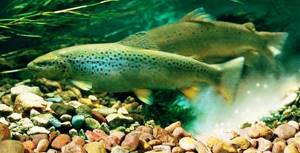
Habitats
The river specimen lives in freshwater places, but adapts to any salinity of water. Some individuals live without changing their habitat. After spawning, they go into holes at the bottom of the river near springs. In this place, the school can live until spring, eating small fish, worms, and crustaceans. In spring, fish move to waterfalls, under steep banks, and to areas where it is cool.

A few shoals are found in Lake Onega, Lake Ladoga, and in reservoirs in Karelia and the Kola Peninsula. Representatives live in the Caucasus, in Lake Sevan. In cold summers, shoals are located at a depth of 10-15 meters; in hot weather they move to cool places.
What can you cook from trout?
Fish does not require long cooking. Lightly fried fish will retain all the nutritional elements in the product. It is unthinkable to imagine a feast without trout baked in the oven under a cheese-mayonnaise crust, stewed red delicacy fish meat with vegetables and herbs. Lightly salted fish will perfectly complement side dishes of potatoes and rice.
By eating meat of any type of trout at least once a week, you will reduce the likelihood of atherosclerosis, optimize brain function, improve memory, the product is rich in phosphorus, which is so useful for mental activity. In addition, the general condition of the body will improve, you will be full of strength, feel cheerful and light!
